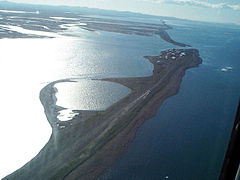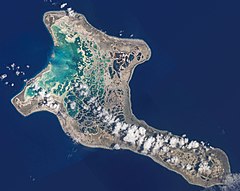Lagoon


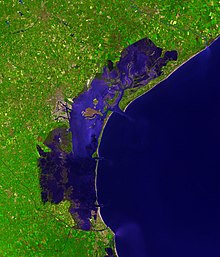
A lagoon is a shallow body of water separated from a larger body of water by a narrow landform, such as reefs, barrier islands, barrier peninsulas, or isthmuses. Lagoons are commonly divided into coastal lagoons (or barrier lagoons) and atoll lagoons. They have also been identified as occurring on mixed-sand and gravel coastlines. There is an overlap between bodies of water classified as coastal lagoons and bodies of water classified as estuaries. Lagoons are common coastal features around many parts of the world.
Definition and terminology
[edit]Lagoons are shallow, often elongated bodies of water separated from a larger body of water by a shallow or exposed shoal, coral reef, or similar feature. Some authorities include fresh water bodies in the definition of "lagoon", while others explicitly restrict "lagoon" to bodies of water with some degree of salinity. The distinction between "lagoon" and "estuary" also varies between authorities. Richard A. Davis Jr. restricts "lagoon" to bodies of water with little or no fresh water inflow, and little or no tidal flow, and calls any bay that receives a regular flow of fresh water an "estuary". Davis does state that the terms "lagoon" and "estuary" are "often loosely applied, even in scientific literature".[1] Timothy M. Kusky characterizes lagoons as normally being elongated parallel to the coast, while estuaries are usually drowned river valleys, elongated perpendicular to the coast.[1][2][3][4][5] Coastal lagoons are classified as inland bodies of water.[6][7]
When used within the context of a distinctive portion of coral reef ecosystems, the term "lagoon" is synonymous with the term "back reef" or "backreef", which is more commonly used by coral reef scientists to refer to the same area.[8]
Many lagoons do not include "lagoon" in their common names. Currituck, Albemarle and Pamlico Sounds in North Carolina,[9] Great South Bay between Long Island and the barrier beaches of Fire Island in New York,[10] Isle of Wight Bay, which separates Ocean City, Maryland from the rest of Worcester County, Maryland,[11] Banana River in Florida, US,[12] Lake Illawarra in New South Wales, Australia,[13] Montrose Basin in Scotland,[14] and Broad Water in Wales have all been classified as lagoons, despite their names. In England, The Fleet at Chesil Beach has also been described as a lagoon.
In some languages the word for a lagoon is simply a type of lake: In Chinese a lake is hu (湖), and a lagoon is xihu (潟湖). In the French Mediterranean several lagoons are called étang ("lake"). Contrariwise, several other languages have specific words for such bodies of water. In Spanish, coastal lagoons generically are laguna costera, but those on the Mediterranean coast are specifically called albufera. In Russian and Ukrainian, those on the Black Sea are liman (лиман), while the generic word is laguna (Лагуна). Similarly, in the Baltic, Danish has the specific Nor, and German the specifics Bodden and Haff, as well as generic terms derived from laguna. In Poland these lagoons are called zalew ("bay"), and in Lithuania marios ("lagoon, reservoir"). In Jutland several lagoons are known as fjord. In New Zealand the Māori word hapua refers to a coastal lagoon formed at the mouth of a braided river where there are mixed sand and gravel beaches, while waituna, an ephemeral coastal waterbody, is neither a true lagoon, lake, nor estuary.[15]
Some languages differentiate between coastal and atoll lagoons. In French, lagon refers specifically to an atoll lagoon, while coastal lagoons are described as étang, the generic word for a still lake or pond. In Vietnamese, Đầm san hô refers to an atoll lagoon, whilst Đầm phá is coastal.
In Latin America, the term laguna in Spanish, which lagoon translates to, may be used for a small fresh water lake in a similar way a creek is considered a small river. However, sometimes it is popularly used to describe a full-sized lake, such as Laguna Catemaco in Mexico, which is actually the third-largest lake by area in the country. The brackish water lagoon may be thus explicitly identified as a "coastal lagoon" (laguna costera). In Portuguese, a similar usage is found: lagoa may be a body of shallow seawater, or a small freshwater lake not linked to the sea.
Etymology
[edit]Lagoon is derived from the Italian laguna, which refers to the waters around Venice, the Venetian Lagoon. Laguna is attested in English by at least 1612, and had been Anglicized to "lagune" by 1673. In 1697 William Dampier referred to a "Lagune or Lake of Salt water" on the coast of Mexico. Captain James Cook described an island "of Oval form with a Lagoon in the middle" in 1769.[16]
Atoll lagoons
[edit]
Atoll lagoons form as coral reefs grow upwards while the islands that the reefs surround subside, until eventually only the reefs remain above sea level. Unlike the lagoons that form shoreward of fringing reefs, atoll lagoons often contain some deep (>20 m (66 ft)) portions.
Coastal lagoons
[edit]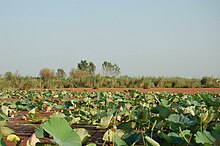
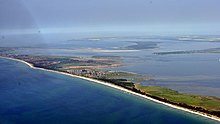
Coastal lagoons form along gently sloping coasts where barrier islands or reefs can develop offshore, and the sea-level is rising relative to the land along the shore (either because of an intrinsic rise in sea-level, or subsidence of the land along the coast). Coastal lagoons do not form along steep or rocky coasts, or if the range of tides is more than 4 metres (13 ft). Due to the gentle slope of the coast, coastal lagoons are shallow. A relative drop in sea level may leave a lagoon largely dry, while a rise in sea level may let the sea breach or destroy barrier islands, and leave reefs too deep underwater to protect the lagoon. Coastal lagoons are young and dynamic, and may be short-lived in geological terms. Coastal lagoons are common, occurring along nearly 15 percent of the world's shorelines. In the United States, lagoons are found along more than 75 percent of the Eastern and Gulf Coasts.[3][4]
Coastal lagoons can be classified as leaky, restricted, or choked.[17] Coastal lagoons are usually connected to the open ocean by inlets between barrier islands. The number and size of the inlets, precipitation, evaporation, and inflow of fresh water all affect the nature of the lagoon. Lagoons with little or no interchange with the open ocean, little or no inflow of fresh water, and high evaporation rates, such as Lake St. Lucia, in South Africa, may become highly saline. Lagoons with no connection to the open ocean and significant inflow of fresh water, such as the Lake Worth Lagoon in Florida in the middle of the 19th century, may be entirely fresh. On the other hand, lagoons with many wide inlets, such as the Wadden Sea, have strong tidal currents and mixing. Coastal lagoons tend to accumulate sediments from inflowing rivers, from runoff from the shores of the lagoon, and from sediment carried into the lagoon through inlets by the tide. Large quantities of sediment may be occasionally be deposited in a lagoon when storm waves overwash barrier islands. Mangroves and marsh plants can facilitate the accumulation of sediment in a lagoon. Benthic organisms may stabilize or destabilize sediments.[3][4]
Largest coastal lagoons
[edit]| Lagoon | Area | Country |
|---|---|---|
| New Caledonian lagoon | 24,000 km2 (9,300 sq mi) | |
| Garabogazköl | 18,000 km2 (6,900 sq mi) | |
| Lake Maracaibo | 13,512 km2 (5,217 sq mi) | |
| Lagoa dos Patos[a] | 10,100 km2 (4,000 sq mi) | |
| Albemarle-Pamlico sound system | 7,800 km2 (3,000 sq mi) | |
| Lagos Lagoon | 6,354.7 km2 (2,453.6 sq mi) | |
| Curonian lagoon | 1,619 km2 (625 sq mi) | |
| Mayotte lagoon | ~1,500 km2 (600 sq mi) | |
| Rangiroa lagoon | 1,446 km2 (600 sq mi) | |
| Chilika Lake | 1,165 km2 (450 sq mi) during monsoon season, 906 km2 (350 sq mi) during dry season | |
| Indian River Lagoon | 910 km2 (353 sq mi)[18] | |
| Vistula lagoon | 838 km2 (324 sq mi) | |
| Biscayne Bay System —Biscayne Bay (traditional) |
703 km2 (271 sq mi)[19] 572 km2 (221 sq mi)[20] |
|
| Marovo lagoon | 700 km2 (270 sq mi) | |
| Szczecin Lagoon | 689 km2 (266 sq mi) | |
| Venetian lagoon | 550 km2 (210 sq mi) |
Images
[edit]-
Aerial view of Bora Bora in French Polynesia.
-
Aerial view of Kivalina, Alaska from the northwest.
-
Nearly half the area of Kiritimati is covered with lagoons, some freshwater and some seawater.
-
Panoramic view of Lefkada City Lagoon, Lefkada Isl., Ionian Islands Prefecture, Greece.
-
Panoramic view of Prokopos Lagoon, Achaia, Western Greece Prefecture, Greece.
-
Tropical lagoon in Bacuit Bay, Palawan, Philippines.
-
Photo of Mar Menor as seen from International Space Station.
See also
[edit]Notes
[edit]References
[edit]- ^ a b Davis, Richard A. Jr. (1994). The Evolving Coast. New York: Scientific American Library. pp. 101, 107. ISBN 978-0-7167-5042-0.
- ^ Allaby, Michael, ed. (1990). "Lagoon". Oxford Dictionary of Earth Sciences. Oxford: Oxford University Press. ISBN 978-0-19-921194-4.
- ^ a b c Kusky, Timothy, ed. (2005). "Lagoon". Encyclopedia of Earth Sciences. New York: Facts on File. p. 245. ISBN 0-8160-4973-4.
- ^ a b c Nybakken, James W., ed. (2003). "Lagoon". Interdisciplinary Encyclopedia of Marine Sciences. Vol. 2 G-O. Danbury, Connecticut: Grolier Academic Reference. pp. 189–90. ISBN 0-7172-5946-3.
- ^ Reid, George K. (1961). Ecology of Inland Waters and Estuaries. New York: Van Nostrand Reinhold Company. p. 74. ASIN B003MRW6AK.
- ^ Maurice L. Schwartz (2005). Encyclopedia of coastal science. Springer. p. 263. ISBN 978-1-4020-1903-6. Retrieved 31 March 2012.
- ^ Kjerfve, Björn (1994). "Coastal Lagoons". Coastal lagoon processes. Elsevier. pp. 1–3. ISBN 978-0-444-88258-5.
- ^ Aronson, R. B. (1993). "Hurricane effects on backreef echinoderms of the Caribbean". Coral Reefs. 12 (3–4): 139–142. Bibcode:1993CorRe..12..139A. doi:10.1007/BF00334473. S2CID 879073.
- ^ Jia, Peng and Ming Li (2012). "Circulation dynamics and salt balance in a lagoonal estuary". Journal of Geophysical Research: Oceans. 117 (C01003): C01003. Bibcode:2012JGRC..117.1003J. doi:10.1029/2011JC007124. Archived from the original on Aug 19, 2014. Retrieved 24 March 2012.
- ^ Goodbred, S. Jr., P. Locicero, V. Bonvento, S. Kolbe, S. Holsinger. "History of the Great South Bay estuary:Evidence of a catastrophic origin". State University of New York. Retrieved 24 March 2012.
{{cite web}}: CS1 maint: multiple names: authors list (link) - ^ Boynton, W. R., J. D. Hagy, L. Murray, C. Stokes, W. M Kemp (June 1996). "A Comparative Analysis of Eutrophication Patterns in a Temperate Coastal Lagoon" (PDF). Estuaries. 19 (2B): 408–421. doi:10.2307/1352459. JSTOR 1352459. S2CID 14978943. Retrieved 24 March 2012.
{{cite journal}}: CS1 maint: multiple names: authors list (link) - ^ "Total Maximum Daily Loads for the North and Central Indian River Lagoon and Banana river Lagoon, Florida" (PDF). United States Environmental Protection Agency. Archived from the original (PDF) on 24 September 2015. Retrieved 24 March 2012.
- ^ "Proposed Swimming Enclosure Net, Entrance Lagoon, Lake Illawarra" (PDF). Lake Illawarra Authority. Archived from the original (PDF) on 28 February 2011. Retrieved 24 March 2012.
- ^ Bird, Eric C. F. (2010). Encyclopedia of the World's Coastal Landforms. Vol. 1. Dordrecht: Springer. p. 485. ISBN 978-1-4020-8638-0.
- ^ Kirk, R.M. and Lauder, G.A (2000). Significant coastal lagoon systems in the South Island, New Zealand: coastal processes and lagoon mouth closure. Wellington, N.Z.: Department of Conservation. ISBN 0-478-21947-4.
{{cite book}}: CS1 maint: multiple names: authors list (link) - ^ "Lagoon". Oxford English Dictionary. Vol. I A-O (Compact ed.). Oxford, England: Oxford University Press. 1971. p. 1560.
- ^ a b Kjerfve, Björn (1986). "Comparative oceanography of coastal lagoons". Estuarine Variability. Elsevier. pp. 63–81. doi:10.1016/b978-0-12-761890-6.50009-5. ISBN 978-0-12-761890-6.
- ^ "Fast facts about the Indian River Lagoon". St. Johns River Water Management District. 2024. Retrieved 12 July 2024.
- ^ Smith, Ned P. (Summer 2001). "Tides of Biscayne Bay, Card Sound, Little Card Sound, Barnes Sound, and Manatee Bay, Florida". Florida Scientist. 64: 224. JSTOR 24321024.
- ^ Milano, Gary R. (2000). "Introduction". Island Restoration and Enhancement in Biscayne Bay, Florida (PDF). Miami-Dade Department of Environmental Resources Management (Report). Retrieved April 21, 2021.



